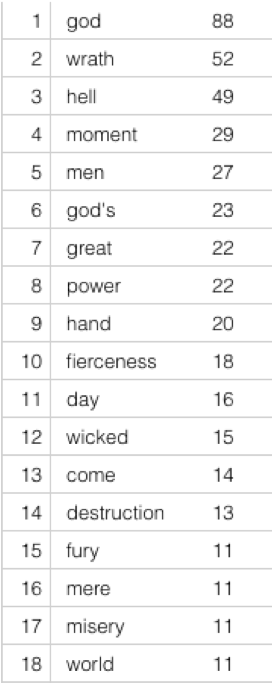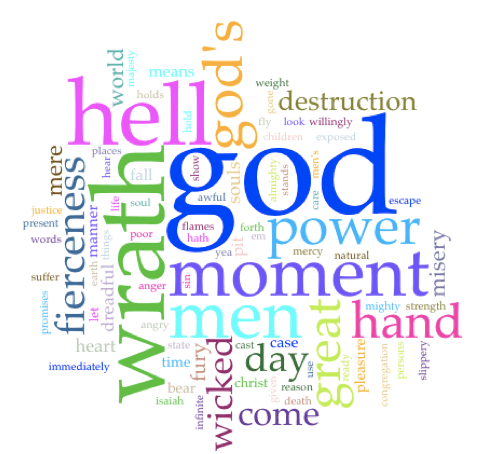On Sunday, 8 July 1741, pastor Jonathan Edwards delivered his most famous sermon, Sinners in the Hands of an Angry God, to a church in Enfield, Connecticut. Reportedly, he delivered the sermon in a monotone voice, yet the congregation reacted passionately – fanatical crying, falling to their knees, begging. I found this surprising – wouldn’t an audience tire of a dreary voice – until I learned of the context that makes Edwards out to be quite clever. The American colonies during the 1730s and 40s experienced a religious revivalist movement known as the Great Awakening. Most of the colonists were Puritans, known for their intense religious fervor. Knowing this and reading the sermon again, I realized that Edwards didn’t rely on his vocal performance to garner an emotional response, but used deliberate word choice to trigger the churchgoers’ spiritual convictions.
For my digital humanities project, I wanted to illustrate and track the word associations in order to supplement study of the imagery and concepts used in Sinners in the Hands of an Angry God, especially as the ones that affected the congregation. To do this, I inserted the text into Voyant-Tools.com, which contains a plethora of gadgets for visualizing textual details.
Here is the link to my voyant. It opens to the workstation with five tiles holding different tools, but I only used the top three: Terms, Cirrus, and Links. Feel free to collapse the bottom two for simplicity.

With the Terms tool, I generated a list of the 1,135 unique words identified in the sermon in the order of the amount of times they appear in the text. When multiple words share the same frequency, they are displayed in alphabetical order. Figure 1 is the list of the top eighteen most occurring words. While Terms does detail the frequencies of these words, it is admittedly in a visually-uninteresting format. It serves more of a numerical reference that supplements the second tool.
Cirrus produces a word cloud illustrating how often a word is used in a cluster of words in various sizes. The bigger the word, the more often it appears in the text. Note that the word cloud regenerates each time the webpage is loaded and whenever the workstation is altered. The number of words present will change depending on the amount “Terms” is set to. With a range between 25 and 500, I recommend setting it to 85, all words that appear six or more times. A word cloud under these settings is pictured in Figure 2.

Referring back to the terms list, the world cloud accurately reflects the frequency of each unique word found in the sermon. The top three – god (88), wrath (52), and hell (49) – are the largest and most prominent in the image. The next five – men (27), god’s (23), great (22), power (22), and hand (20) – may be smaller but still notably large. Fierceness, day, come, wicked, and destruction are another size smaller. Fury (11), misery (11), mere (11), and world (11) are the last easily discernable words present. The rest are still legible, but rather small.
From the results of both the Terms and Cirrus tools, one can infer and confirm general concepts found in the sermon. For instance, it’s rather expected that god would be the most used word, given this is a Christian sermon featuring God as a central topic. The prominence of wrath and fury fits Edwards’s characterization of an “Angry God,” hence the title. Abundant usage of hell shows it was mentioned a lot and plays a major role in Edwards’s message.
Although, I find that simply noting the frequencies of such words does not provide all the details. The words alone are rather non-descriptive for the greater context. For instance, with men being a frequent word in the sermon, suggests that Edwards talked a lot about people, but it does not indicate whether he spoke about certain groups of people or humanity as a whole. It also doesn’t tell how he referred to such people. There are also words that, due to their abstraction, are not significantly informative by their frequency alone, such as moment, mere, and hand.
For a more in-depth coverage of the themes in the sermon, I employed the Links tool to illustrate associations between word derived from the text. Figure 3 shows a simple link for one term, in this example god, as shown in the blue box. The orange boxes are the top five words with a close relationship with god. The extending lines detail the connections between words with their thickness exemplifying how often said relation appears. By exhibiting these correlations between words, Links prove themes and ideas found in the sermon. In this instance, god bearing a close connection with wrath and fierceness further characters God as an angry deity. Mere and pleasure suggests that God enjoys His ire, the two words often found together in the text.
For hand, I added it as a base term in Figure 4 to show its associations with other words and further detail the context here. As displayed in the darker boxes, god’s defines an ownership over His hand, held and withdraw seem to be actions God’s hand is committing.

For hand, I added it as a base term in Figure 4 to show its associations with other words and further detail the context here. As displayed in the darker boxes, god’s defines an ownership over His hand, held and withdraw seem to be actions God’s hand is committing.

Yet this doesn’t define what specifically what God’s hand is doing. To do so, I extended the Links by adding men, as shown in Figure 5. It has an association with hand, god, hell, and cast, as well as the previously undefined word moment. This suggests that God is acting upon men, possibly to cast them into hell, in reference to the angry god characterization.

As a demonstration of all these links reflecting sermon, consider Edwards’s quote: “natural men are held in the hand of God over the pit of hell… His anger is as great towards them as to those that are actually suffering the executions of the fierceness of his wrath in hell, and they have done nothing in the least to appease or abate that anger, neither is God in the least bound by any promise to hold ’em up one moment” (emphasis mine). Based on the high frequencies these words have, it’s discernable that one of the central tenets in the sermon is condemning unconverted people to an afterlife in hell, which these Links reflect.
This is just one example of the Links in use. More conclusions can be drawn by focusing Links on other words, extending further connections, and comparing them to word usage. Using these Voyant tools helps dissect the concepts found in Sinners in the Hands of an Angry God, I’ve concluded that many of these themes concern Christians’ relationship with God and how their behavior infuriates Him, which would’ve garnered an emotive response from a zealous Christian congregation.
Process
I chose to base my digital humanities project off of Jonathan Edwards’s Sinners in the Hands of an Angry God after learning that Edwards delivered the sermon with a monotone and the congregation’s passionate reaction. Even though I had studied the sermon in high school, learning this fact in college reinvigorated my fascination for the text. I wondered how a seemingly dull vocal performance could rise such as emotive response out of people rather than boring them. Exploring the tools in Voyant not only unveiled the spiritual themes used in the sermon, they also told reflected other concepts into an easily-digestible format.
After finding the text online to copy-and-paste into Voyant, I practiced using the library of tools available before settling on three: Cirrus, Terms, and Links. Cirrus generates a word cloud and has an adjustable slider to manage the amount of words shown. Terms lists every word in plain text alongside the number of times a word appeared in the text. Links illustrates connections between words based on the frequency they occurred together as word boxes attached to lines of varying thickness.
Originally, I was going to work with the entire text unedited until I realized Voyant was accounting for rather minor and insignificant words. While it was already ignoring most articles and prepositions, their older English forms were being considered unique terms and sometimes appeared in the Cirrus and Links, replacing what would’ve been a more noteworthy term. Since these words signified no notable connections, I decided to remove them from the text. I copied-and-pasted the text into a Word document, used the Find-and-Replace tool to swap these words with empty spaces, and inserted the culled text into Voyant. This had no effect on the Links aside from removing the squatters. These included ye, thus, thy, ‘tis, shall, et cetera. I did decide to keep mere, yea, and hath since I found they had impactful connotations.
I used the same method to merge together different forms of the same word, which was also being considered separate unique terms and creating unnecessary redundancy in the Links. Though, some words I left alone – for instance, god and god’s – because Voyant offers the option to merge such versions together under an asterisk (god*), denoting multiple forms of the same word at once. However, this option didn’t exist for men and man, which produced repeated links between the same words with few individuals, so using Word’s Find-and-Replace tool, I turned all iterations of man into men. I should note that there were some words I missed and didn’t merge, but did not impact the comprehension of the project in a negative manner.
I did consider cutting out any words that appeared less than a set number of times as “insignificant.” Though, given I could not settle on an “insignificant” threshold, I decided against it. Also, there were so many “insignificant” words, that cutting them out would be time consuming. 655 words appear only once, 206 show twice, and 107 appear trice. I also realized that their removal would be detrimental to the clarity of the project. There are words that, despite making few appearances, still supplemented the concepts presented in the sermon. For instance, bottomless only appears two times in the text, but as illustrated in the Links, has a close association with pit, which in turn is a descriptor for hell. The idea of the “bottomless pit of hell” is popular in Christian mythos and used a few times in the sermon as a fear tactic. Removing bottomless would have neglected this fact and I didn’t want such problems to occur by deleting other words.
I continued to surf the Links in order to identify ideas used in the sermon based on word associations. For simplicity, I had the idea to categorize the words into the three categories “men,” “god,” and “hell,” The idea did start by reading through the sermon, but tracing the Links later reaffirmed the concept. I wrote down a chart listing descriptor words identified from the reading that were reinforced by the Links, as listed below.

The connections did not have to be direct. As long as the extending links fell within the same topic or, if associated with a new subject, was an actor upon the new subject, then the word fell within one of these three categories.
My publication details this process starting with god, which descended into God’s hand acting upon men. I used that as an example since it encompassed the major theme in the sermon as well as answered my question. Edwards didn’t use an antagonistic vocal performance to supplement his preaching that day because the fear-mongering language would be sufficient to scare a religious congregation into believing God was going to send them to hell, where no Christian wants to go to.